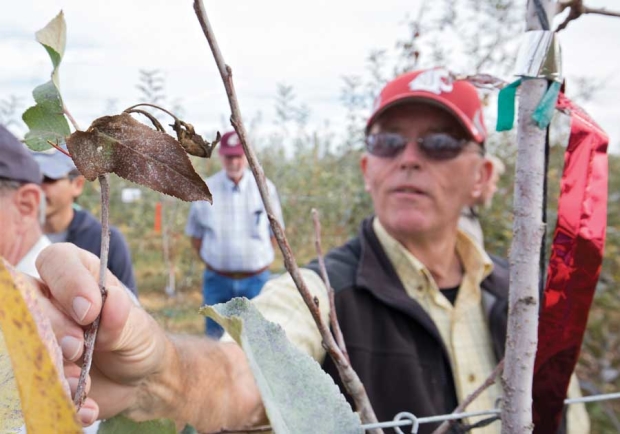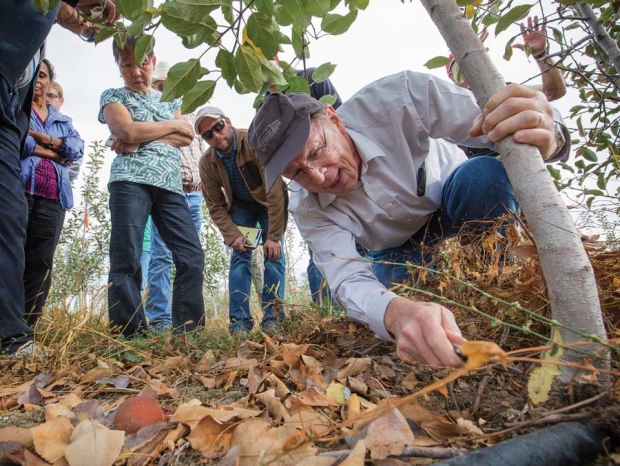
The Washington Tree Fruit Research Commission’s rootstock field day on October 21, 2015 in Wapato, Washington, covering fire blight resistance. (TJ Mullinax/Good Fruit Grower)
Historically, the Konnowac Pass area near Wapato, Washington, has been known for Bartlett pear production for the canning industry.
Of course, pears are particularly susceptible to fire blight, and that history — combined with prime weather conditions last year — are triggering a test bed for the disease at a rootstock trial site owned by the Washington Tree Fruit Research Commission near the USDA entomology laboratory in Wapato.
A Gala replacement tree rootstock trial is underway there to better understand the replant disease tolerance in orchards with occasional tree losses.
It turns out, this block of Gala also has acquired significant fire blight pressure due to the unique weather of 2015.
Unfortunately, the block is mostly on Malling 9 rootstock, which is highly susceptible to fire blight. Nearly 10 percent of the M.9 trees planted in 2010 have had the rootstock die, as of September 2015.
The circumstances are giving researchers there an unplanned opportunity to learn more about fire blight, and better understanding the disease is crucial to the industry.
“Growers are spending $50,000 an acre to plant a new orchard. We can’t have any tree losses due to fire blight after planting new trees,” said Tom Auvil, horticulturist with the Washington Tree Fruit Research Commission.
Ground zero for fire blight

Tom Auvil, right, shows how fire blight passed from the tree on the right to the tree he’s holding during the October rootstock field day in Wapato, Washington. (TJ Mullinax/Good Fruit Grower)
Fire blight is caused by the bacterium Erwinia amylovora.
The bacteria overwinter in cankers and can float in the air before coming to rest on flowers in the spring, colonizing the stigma prior to being washed into the base (floral cup or nectary) of the flower by dew or rain.
The flower cluster becomes blighted, and bacteria enter the vascular system of the tree. Early season dieback of shoots starts from flower infections.
The bacteria move with water, wind and insects, and any event that wounds tissue — such as hail or wind — provides infection opportunities.
The bacteria begin to multiply once temperatures are greater than 65°F. Growers should turn to fire blight models to determine their risk level once temperatures begin to get into the 70s.
The research plot near Wapato sits in a bowl of flat ground in an extended area where temperatures can warm quickly and with high potential for dew to appear well up in the tree. The area includes roughly 30 acres of pears, as well as 20 acres of apples, including a 2010 planting of 15 acres of Gala.
The first thing researchers noted last year: Roughly one in 10, or 10 percent, of the trees planted in 2010 defoliated, and on each of those trees, the rootstock died before dormancy. An earlier planting in 2006 didn’t have anywhere near the amount of fire blight, Auvil said.
Gala has a unique feature where some spurs will bloom a few days after the one-year wood — a kind of double bloom that is similar to Barlett pears, he said, which opens the susceptibility window for fire blight. Add in the high potential for dew and the inoculate load, and the area was ripe for bacteria to multiply rapidly.
Despite the region’s historical susceptibility to fire blight, this is the first time the research block has really been clipped by it, Auvil said.
“Whatever conditions occurred in 2015, we just had a little uptick in that delayed bloom, plus some bloom in August/September, then the weather triggered the blight infections.”
Learning opportunities
In some seasons, trees bloom in August and September, dramatically increasing the risk of tree infection through flowers. M.9 and M.26 rootstocks do not need visual strikes of fire blight in the scion to acquire the disease below ground.
In the research block, trees from the 2010 planting on M9.337 rootstock were most likely to have died — in some cases, without a visual strike in the scion.
A few planted in 2015 on Budavosky 9 experienced strikes but did not die. There were a few strikes in trees on Geneva rootstocks planted in 2004 and 2006 that have not spread into the tree as a whole.
“I don’t want to say a Geneva tree will never die from fire blight, but unlike M.9, the percentage that you’ll lose will likely be insignificant,” he said.
Many of the 2015 replacement trees on Geneva and the M.9 trees planted as comparisons for the Geneva rootstocks were stubbed back to 4 inches at planting, removing nearly all the bloom that would have created significant risk of blight infection.
Auvil said researchers will be working with the orchard operator at the Wapato block closely, advising to pull dead trees, prune strikes and manage cankers in the orchard. He advised growers with fire blight issues to do the same.
“If you have a relatively young, vigorous orchard with M.9 rootstock, you have to be very aggressive at getting the inoculum load down,” he said.
That means pulling out trees with dead rootstock, monitoring the block from green tip through bloom looking at every rootstock union to check for a fire blight that may be oozing vast quantities of inoculum out of the union.
“As diligent as one can be to get it out of the field, it won’t cure the problem. It takes two, almost three years of seeing no strikes before you can breathe a sigh of relief on blight management,” he said. “It’s a relatively intense period of time.”

Tim Smith cuts into a young Gala tree looking for fire blight damage during the field day. (TJ Mullinax/Good Fruit Grower)
Tim Smith, regional WSU Extension educator, also noted that growers should take care when diagnosing their trees with disorders other than fire blight, such as collar rot, that can present similar symptoms.
“People diagnose tree death as collar rot, but M.9 is actually pretty resistant to collar rot,” he said. “I believe 99 percent is actually fire blight.”
Smith and Auvil also said the Wapato orchard will present an opportunity to learn more about the disease over time.
Aaron Clark, field manager for Price Cold Storage and Packing Co. in Yakima, said Price’s orchards located near the field plot didn’t experience significant fire blight last year, but it’s been an issue in the past — particularly in a couple of older Bartlett blocks.
“You just don’t have Bartletts without having some blight once in a while. That’s like putting your boots on in the morning,” he said.
But he said the company has been diligent to stay on top of the disease, given that they have some young plantings, including 3-year-old Gala blocks that were planted from a sleeping eye.
That includes examining the orchards regularly, aggressively cutting out cankers and treating for blight with a prophylactic approach whether they think they have an infection or not. Treatment methods include copper, the antibiotics streptomycin or terramycin and other products that help to retire blight.
“We just try to take a forward approach to covering, so that we’re applying some kind of blight protection every week. Otherwise, you get a weather system in that gives you a blight exposure, and invariably the weather is cruddy for a couple of days and you don’t get in there to do it,” he said. “And you’re too late.” •
– by Shannon Dininny






This is exactly what I have been dealing with in the Milton Freewater area. M9 Fuji younger than 6 years old being the the worst case scenario for me. What is puzzling to me is when there are no blight strikes on the trees, the rootstock dies and therefore the scion collapse. When I sample the ooze in August through October and send in for confirmation that the tree died from fireblight, I have received different results from different labs. This creates great uncertainty. Why?